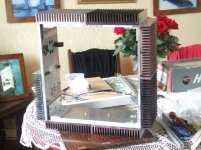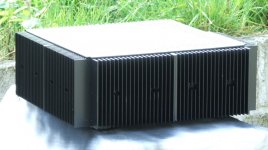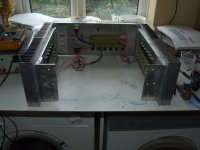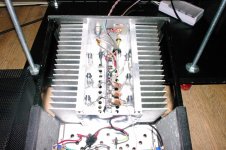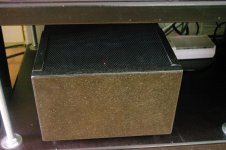What I gained from reading it is that tall heatsinks are better heatsinks.
Thermal conductance is watt per degree temperature difference, actually derived by taking a temperature difference and see what the capability in watts is.
Thermal resistance (the Rha of a heatsink) is not derived directly from theory, but it's merely the reciproke value of thermal conductivity.
[aka, pro guys calculate with W/C (W/K), not with C/W (K/W) ]
1 : Air goes up, and becomes hotter along the tallness of a heatsink. (through heat exchange between heatsink and ambient air)
2 : The further up from a heat source, the cooler a heatsink surface will be. (see line up)
1+2 : the taller/higher up, the smaller the temperature difference between ambient and heatsink becomes.
aka, smaller temperature difference => less watt capability.
=> the taller/higher a heatsink, the less efficient.
OK but...
And I'm not arguing... I concluded from the "increased speed of airflow" (mentioned on one thread on DIY heatsinks) along a taller fins, cooling would be better. I guess not.
Hey, I'm trained as an artist not an engineer. I look at what the smart guys are doing and try to find out why they do it.
There are some mighty SS amps arranged in a vertical format like the Mark Levinson No 53 and there are the KSA50's with a veritable landscape of fins. It is hard to know what is just packaging and what is actually best.
Does heat radiate uniformly along the thick base and then to the fins or does it tend to migrate upwards (given a uniform array of heat fins)? One needs airflow to cool the fins but how is it generated (by means of proper configuration not fans)?
I don't expect perfect answers but if just plain goods ones are to be had please let fly. At the moment 6 inch tall fins are in the lead...
Cheers!
And I'm not arguing... I concluded from the "increased speed of airflow" (mentioned on one thread on DIY heatsinks) along a taller fins, cooling would be better. I guess not.
Hey, I'm trained as an artist not an engineer. I look at what the smart guys are doing and try to find out why they do it.
There are some mighty SS amps arranged in a vertical format like the Mark Levinson No 53 and there are the KSA50's with a veritable landscape of fins. It is hard to know what is just packaging and what is actually best.
Does heat radiate uniformly along the thick base and then to the fins or does it tend to migrate upwards (given a uniform array of heat fins)? One needs airflow to cool the fins but how is it generated (by means of proper configuration not fans)?
I don't expect perfect answers but if just plain goods ones are to be had please let fly. At the moment 6 inch tall fins are in the lead...
Cheers!
Packaging meets various needs. ML chose style over maximum efficiency. All engineering is a study in tradeoffs.
An closed chimney would tend to increase airflow more than tall open fins and would be more efficient.
As you move away from the heat source the temperature decreases. That means further from the source the temperature difference is smaller so less heat is emitted. Thick base profiles conduct better so the temperature difference is less with distance.
Given a choice between sinks of the same size and fin length, the one with the thicker base will be slightly more efficient. In some cases, with one very high heat source you need all the conduction you can get and a heat spreader like TC-1050 is helpful. www.momentive.com/WorkArea/Download...=SrsN-FizOMSbBzmNgPx5kw&bvm=bv.50165853,d.dmg Of course, you need a military budget to get it...
An closed chimney would tend to increase airflow more than tall open fins and would be more efficient.
As you move away from the heat source the temperature decreases. That means further from the source the temperature difference is smaller so less heat is emitted. Thick base profiles conduct better so the temperature difference is less with distance.
Given a choice between sinks of the same size and fin length, the one with the thicker base will be slightly more efficient. In some cases, with one very high heat source you need all the conduction you can get and a heat spreader like TC-1050 is helpful. www.momentive.com/WorkArea/Download...=SrsN-FizOMSbBzmNgPx5kw&bvm=bv.50165853,d.dmg Of course, you need a military budget to get it...
Hi Bob.
that sounds all very interesting, and i would like to know more about the heat spreader, but the link is dead.
Mat
that sounds all very interesting, and i would like to know more about the heat spreader, but the link is dead.
Mat
Copy/paste Bob's link without the ,d.dmg/
Attachments
Last edited:
that TC - 1050 is not a heat spreader.
Note the different Thermal conductivity in the two directions.
Note the different Thermal conductivity in the two directions.
that TC - 1050 is not a heat spreader.
Note the different Thermal conductivity in the two directions.
there are finned heatsinks of the tc-1050. if the heat conductivity is 3X that of copper, or about 3X, it should make one hell of an good cooler. at least as far as i understand the theory.
i think the big problem will be the price, although i have not yet found more info on that.
Andrew is correct, it is rather directional. I'd missed that part, I was just in awe of it's conductivity. I ran into the stuff working on a project to cool high powered avionics. It was used in the SEM-E cards to take heat to the cold wall that our system cooled. I don't know if the underlying crystal structure can be manipulated to provide more omnidirectional but considering the troubles they ran into getting it to reliable production in its current form, anything different will be ultra expensive.
I threw it up there just to show something cool, not as a realistic solution. Its cost is likely only justifiable if you absolutely have to get 200+ W off a SEM-E form factor card. It beat out a water cooled solution with quick disconnects because of not having potential leaks, despite higher cost. The water cooled cold plate (roughly 5" x 7") and quick disconnect combo was around $900.
I threw it up there just to show something cool, not as a realistic solution. Its cost is likely only justifiable if you absolutely have to get 200+ W off a SEM-E form factor card. It beat out a water cooled solution with quick disconnects because of not having potential leaks, despite higher cost. The water cooled cold plate (roughly 5" x 7") and quick disconnect combo was around $900.
just in awe
Means it's a heat spreader (think heat pipe).
That the material has an oriented/channelled structure, inherently makes it 2D directional.
For practical purposes, the TC-1050 would be a thin tile that's attached to an aluminum heatsink (which does have uniform heat distribution)
Still awesome material for cooling purposes.
Heat can be viewed as water. Funny statement I know but bear with me.
If you were to make a thin walled container the shape of your heatsink - like a box with arms. Then make an inlet where you intend to mount the source of the heat, the MOS-FET in this case.
If you were to drill millions of tiny holes in the surface of the box, watch and see how the hot water escapes.
Most heatsinks have thick bases and tapering arms.
If you were to make a thin walled container the shape of your heatsink - like a box with arms. Then make an inlet where you intend to mount the source of the heat, the MOS-FET in this case.
If you were to drill millions of tiny holes in the surface of the box, watch and see how the hot water escapes.
Most heatsinks have thick bases and tapering arms.
eventually the water will find its way to all the holes and come out every were.
but still, the largest amount of water will be coming out near to the source.
heat will do the same providing the heat sink is perfect.
the smallest change in material will change the heat pattern.
still, a heat spreader is a beautiful piece of material, but you can also just do the same as i do, double up on your heatsinks, that way even an aleph won't get hot.
but still, the largest amount of water will be coming out near to the source.
heat will do the same providing the heat sink is perfect.
the smallest change in material will change the heat pattern.
still, a heat spreader is a beautiful piece of material, but you can also just do the same as i do, double up on your heatsinks, that way even an aleph won't get hot.
To carry that analogy further, think of filling the sink with an open cell foam. Different materials have different pore sizes, meaning the water flow is restricted differently. Copper has big holes, Aluminum a bit smaller and steel smaller still.
i am just thinking aloud here, but would mercury be a good heat spreader?
make a thin walled enclosure, leak proof, fill it with mercury and than attach it to a normal heatsink.
i know it is not practical, but i am just trying to learn a thing or two here.
make a thin walled enclosure, leak proof, fill it with mercury and than attach it to a normal heatsink.
i know it is not practical, but i am just trying to learn a thing or two here.
Here's the Aleph 4 that I inherited from my brother-in-law. Just goes to show how to get rid of a LOT of heat.
Attachments
Last edited:
aleph 5 running at just about 10 degrees C above ambient.
edit: strange, i can not get the pictures up at the moment.
edit: strange, i can not get the pictures up at the moment.
Last edited by a moderator:
That's cool. The Aleph 4 is 100W / Channel and runs about 30 degrees above ambient unless all the doors are open and it gets a little breeze.
my amps have a perforated cover over it with 2mm holes, i think that that is the only reason i can get some heat in there.
the cover is a wrap around, only the bottom of the heatsinks is open and about 3cm above the floor.
the cover is a wrap around, only the bottom of the heatsinks is open and about 3cm above the floor.
Attachments
i am just thinking aloud here, but would mercury be a good heat spreader?
make a thin walled enclosure, leak proof, fill it with mercury and than attach it to a normal heatsink.
i know it is not practical, but i am just trying to learn a thing or two here.
Not sure about the thermal conductivity, but the mechanical expansion coefficient that makes it so good for thermometers would make it problematic unless you allowed expansion volume. Ok for vertical applications, horizontal not so much.
The major issue bringing TC-1050 to market was controlling the different expansion rates of the aluminum and the core. Early on it would delaminate, destroying its thermal conductivity. I presume that this has been resolved in the 15 years since I discovered it.
- Status
- Not open for further replies.
- Home
- Amplifiers
- Pass Labs
- DIY heatsinks
